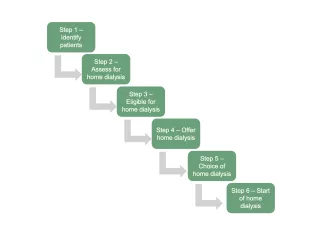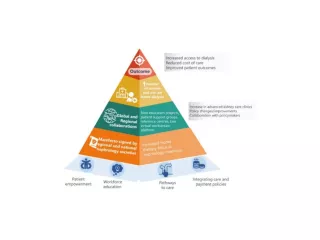ISN & ISPD Join Forces to Issue International Home Dialysis Manifesto
A reflection by Richard Booth, Lead for Chronic Therapies, Medical Affairs A/NZ
Despite known lifestyle benefits and lower costs, home dialysis is still underutilised in many countries. This variability extends from variable usage in high-income countries to not being available or being underused in low-income countries. To help address some of the challenges in increasing the use of home dialysis, the International Home Dialysis Consortium (IHDC) was formed as a joint project across the International Society of Nephrology (ISN) and the International Society for Peritoneal Dialysis (ISPD) with representatives from other major nephrology societies and industry partners.
A launch meeting of the consortium at the World Congress of Nephrology (WCN) 2024 in Buenos Aires, discussed four key areas:
- Empowering people needing dialysis
- Workforce education
- Developing workforce and resources
- Integrating care and payment policies
Empowering people needing dialysis
A lack of awareness of home dialysis remains a critical barrier to adoption and several studies have shown that education allows patients to make informed choices. The education needs to go beyond the patient and include the wider circle of care, including care givers (family, partners etc.) and care providers (nephrologist, nurses etc.). Empowering the entire care team has been shown to impact home dialysis adoption rates.
Workforce education
Education and training of home dialysis providers is essential, yet in many cases resources and opportunities are limited especially in areas with lower home dialysis uptake. The IHDC has proposed the development of reference centres to advance local home dialysis training while staying connected to a global network. These centres would provide education for all members of the nephrology team and facilitate exchange between local, regional and international professionals.
Integrating care and payment policies
It is hard to underestimate the role of policy alignment, provision of fiscal resources, the organisational structure, incentives for providers and accountability in expanding the adoption of home dialysis. When it comes to integrating care and payment policies, the consortium agreed on four key strategic areas:
- Improving cost-effectiveness of home dialysis
- Establishing a framework for advocacy of home dialysis
- An equitable incentive policy
- Outlining an acceptable standard for the delivery of quality care
Introducing the manifesto
The consortium’s efforts highlighted the need for strategies and implementation approaches to expand home dialysis. The first output from the consortium was the production of a manifesto, which has been endorsed by both ISN and ISPD. This manifesto is a declaration advocating for the promotion of home dialysis globally and lists 12 target areas. This manifesto is being presented to professional kidney-related societies, as a potential roadmap to increase home dialysis awareness and modality selection. The manifesto has already been presented at meetings after ISPD in Dubai, WCN in New Delhi, and further meetings have been planned for 2026.
International Home Dialysis Consortium Manifesto
All forms of kidney replacement therapy are potentially lifesaving, and a key priority for all countries should be to ensure that kidney replacement therapy is available and affordable for everyone with kidney failure. However, to those who already have access to kidney replacement therapy, home dialysis has special advantages. Providing home dialysis (peritoneal dialysis and home haemodialysis) holds the promise of enhancing patient experience, quality, and equity in kidney failure care by allowing wider global access to kidney replacement therapies. This manifesto is a public declaration advocating for the promotion of home dialysis globally by:
- Raising awareness of the benefits of home dialysis to people with kidney disease
- Educating all people with kidney failure needing dialysis and their caregivers on all available options, including home dialysis
- Offering home dialysis as part of an integrated patient-centred and value-based care approach for people living with kidney failure in all health care settings
- Enabling people with kidney failure to choose dialysis modality with shared decision-making in all health care settings and with planned or unplanned dialysis start
- Empowering and supporting patients through self-management to have as much responsibility for their dialysis treatment as is appropriate
- Educating and training health care providers, including nephrologists, nurses, primary care providers, dietitians, social workers, and technicians in home dialysis
- Engaging policymakers, payors, and dialysis industry to support home dialysis growth initiatives, adapting actions to local needs and economic realities
- Working with nephrology professional societies, patient advocacy groups, and commercial dialysis providers to develop a global framework to provide home dialysis services
- Creating policy briefs to support advocacy efforts with policymakers
- Creating tools and audit processes to support continuous quality improvement in home dialysis programs
- Facilitating design of reimbursement schemes that are value-based and considering the total costs of delivering dialysis care, including costs of infrastructure
- Ensuring provision of fair and equitable reimbursement for home dialysis, removing financial disincentives and actively promoting optimal patient choice of dialysis modality and location
Supporting the IHDC manifesto
Vantive looks forward to working with our local societies to establish how this manifesto can be realised in Australia and New Zealand. As a passionate advocate for home dialysis, we hope to be a key part of the solution and assist in the achievement of the IHDC’s objectives.
References
-
Gomez NJ, Castner D, Hain DJ, Latham C, Cahill M. Nephrology nursing scope and standards of practice: take pride in practice. Nephrol Nurs J. 2022; 49:313–327

